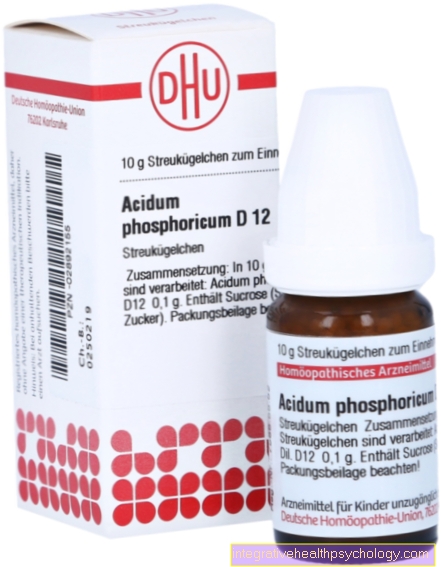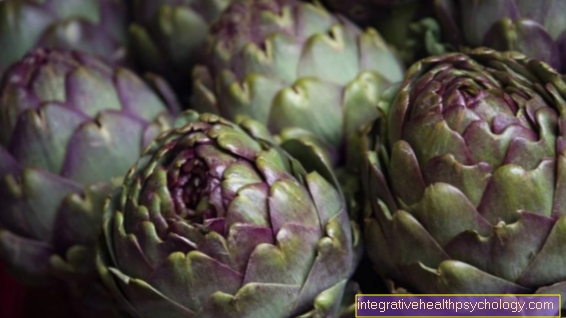Treating the flu
Synonyms
Influenza, real flu, viral flu
Medical therapy

In addition to the targeted antiviral drugs and the antibiotics that may only be used in the case of a bacterial superinfection, there are some other, mostly over-the-counter drugs that can be used - as with a simple cold - to combat or alleviate the symptoms, However, this has no direct influence on the duration of the disease.
These include above all Ibuprofen, paracetamol, and acetylsalicylic acid (Aspirin®), all of which have both analgesic and fever-lowering effects and thus increase well-being.
Read more on the topic Flu medication and general about Antiviral drugs.
For children, acetylsalicylic acid is due to the threat of developing a so-called. Reye's Syndrome however not suitable. Since fever fulfills a meaningful function in the context of the immune defense and thus the fight against the virus, this should not be done in principle, but only at persistently high temperatures above 39 ° C treated so that the recovery process is not delayed.
In the case of a severe cold, decongestants (e.g. xylometazoline), mainly available in the form of nasal sprays, can be used, but the duration of application should not exceed seven days, as otherwise adverse effects may occur after stopping the drug.
Against cough, expectorant and antitussive drugs (e.g. Ambroxol) can be taken.
In addition, there are also various "Flu remedies" available, which consist of a combination of several active ingredients and are intended to combat several flu symptoms at the same time, e.g. Grippostad®, which combines paracetamol with chlorphenamine, vitamin C and caffeine. The fixed combination means that the treatment can only be carried out in a very unspecific manner and there is also the risk of overdosing if patients e.g. do not know that paracetamol is part of the combination and take it in addition. Therefore, the use of such preparations is less recommended and should be replaced by an individual combination of different drugs.
These funds are not suitable for children anyway. There are also a number of herbal remedies from the field of naturopathy, such as Echinacea, as well as some homeopathic remedies that are said to have a supportive effect in the event of flu or a flu-like infection. Even if efficacy has largely not been proven here, such preparations can serve their purpose.
Antibiotics and flu
Antibiotics are basically only against bacteria effective, so they cannot fight the flu virus. However, as the virus infection causes further, additional infections by bacteria (so-called. bacterial superinfections), antibiotics can still be useful. Because often the inflammations caused by bacteria have, among other things, of the lung or the heart muscle have more serious consequences than the flu itself and require further treatment even after the actual viral infection has healed.
Are particularly at risk elderly patients and people with chronic heart and lung diseases, Immunodeficiency or other serious Underlying diseases.
Because antibiotics because of the impending Development of resistance should only be used in moderation and as targeted as possible, it is definitely not advisable to give it as a general rule in the case of flu. The decision for or against additional antibiotic therapy is made individually depending on the existing risk factors, general condition and severity of the infection.
Amantadine prevents the release of genetic material from Viruses in a newly infected host cell. This is a protein, the so-called M2 proteinthat blocked the virus that sits in the shell. As a result of the blockage, the virus can no longer initiate the release of its genetic material, the RNA, and thus can no longer multiply.
Amantadine is only effective against type A influenza viruses and has many side effects, some of which are serious diarrhea, depressions and rarely even epileptic seizures. Many flu viruses are now also resistant to amantadine, which is why it is only rarely used.
The main flu drugs such as B. Oseltamivir (Tamiflu) belong to the new group of drugs called neuraminidase inhibitors.
Neuraminidase inhibitors prevent new viruses from being released from infected cells by blocking the protein neuraminidase. The newly produced viruses thus stick to the infected cell and cannot infect any other cells.
Here, too, treatment must be started within 48 hours of the onset of symptoms in order to ensure a sufficient effect. If treatment is started within one day of the onset of symptoms, the duration of the flu can be reduced by up to 40%. In addition, complications from bacterial superinfection can be prevented in over half of the patients treated.
The neuraminidase inhibitors can also be given prophylactically (as a precaution) to people who have been exposed to the flu virus (Exposition) and belong to the risk group or cannot be vaccinated due to a chicken protein allergy.
Bacterial superinfections can be treated with antibiotics; Because the virus causes the flu, the flu itself cannot be treated with antibiotics.
Duration of treatment
The first symptoms appear one to two days (so-called incubation period) after the infection with the influenza virus has taken place. It is typical of a real flu that the first symptoms set in very suddenly and strongly instead of creeping in.
For the effectiveness or for a noticeable benefit of an antiviral therapy it is extremely important that it is within the first 48 Hours after the onset of symptoms. For oseltamivir e.g.An application period of 5 days is recommended, depending on the severity of the disease, a longer intake is also possible, but this must be decided individually.
Some other drugs used for symptomatic therapy, such as Paracetamol or various combination preparations should not be taken indefinitely over a long period of time without medical advice. The average duration of a flu is approx. 5-7 days. If the disease persists for much longer without any significant improvement in symptoms, a doctor should be consulted anyway.
General measures

With the flu, strict bed rest should be kept for up to three days after the fever has gone down. Paracetamol can be administered against the fever and pain. The active ingredient acetylsalicylic acid, e.g. B. contained in aspirin should never be used in patients under 18 years of age. It is important to have adequate fluid intake, especially if you have a fever, and a diet rich in vitamin C, e.g. in the form of fruit and vegetable juices or food supplements. Home remedies to reduce fever are cold calf compresses with quark, fresh ginger or sage tea is recommended for a sore throat. For severe coughs and runny nose, inhaling mint or eucalyptus oil in hot water provides relief.
In the event of complications, medical advice should be sought immediately, and hospitalization may also be necessary in some cases.
Also read our topic: Grippostad®
Read more on the topic: When should I see a doctor with a fever?
Home remedies
In addition to drug therapy, numerous home remedies are known, none of which, however, specifically target the virus, but rather for symptomatic therapy be used; so they alleviate the discomfort and thus support the healing process. However, their actual benefit and influence on the course of the disease is partly questionable and is assessed very differently by patients.
One of the most famous home remedies is homemade chicken broth, which are anti-inflammatory and supposed to reduce the production of mucus. In addition, the increased fluid intake (also in the form of tea or water) ensures that the increased fluid loss during a fever is compensated and that coughing up is made easier by liquefying the secretion and keeping the mucous membranes moist.
The inhalation of e.g. Eucalyptus, thyme, or Japanese mint oil in hot water may be helpful.
Against a sore throat are among others Sage tea or hot water with lemon juice is recommended as a gargle solution, and nasal rinses with 0.9 percent salt water for colds. In addition, some types of tea and foods such as Honey, ginger, elderberries, sea buckthorn, horseradish or Icelandic moss have been attributed other health-promoting properties due to certain ingredients.
In general, a diet rich in fruit and vegetables can benefit from the numerous vitamins and other ingredients it contains to support the Immune system contribute, so also the well-known vitamin C, which e.g. found in citrus fruits, paprika or sauerkraut. Garlic and onions are said to have antibacterial effects.
Another measure is the application of various wraps, e.g. Leg wrap with lukewarm water for fever or quark wrap around the chest and back for coughs.
Influenza during pregnancy / breastfeeding
Since there is an increased risk of illness and complications (including death and intensive care for the mother as well as stillbirth and premature birth) during pregnancy, also with regard to the flu, the Robert Koch Institute (RKI) and the permanent Vaccination Commission (STIKO) a vaccination with an inactivated vaccine in the second trimester of pregnancy or, in the case of increased health risks due to a chronic illness, already in the first trimester. It is not assumed that the unborn child will be harmed by the virus itself, but the mother's long-term high fever can increase the risk of developmental disorders, which is why medical fever reduction is very important in this case. This mainly happens With Paracetamol, up to 28 weeks of pregnancy can also Ibuprofen be used. Not much is known about the use of antiviral drugs during pregnancy, so this should only be done after strict indications. According to current knowledge, the transfer of such drugs into breast milk is only minor or, depending on the drug, not even known at all, and breastfeeding breaks do not seem to be necessary.





























